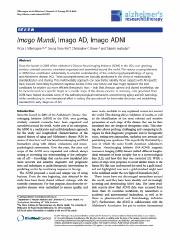Please use this identifier to cite or link to this item:
https://ahro.austin.org.au/austinjspui/handle/1/12526| Title: | Imago Mundi, Imago AD, Imago ADNI. | Austin Authors: | Villemagne, Victor L ;Kim, Seong Yoon;Rowe, Christopher C ;Iwatsubo, Takeshi | Affiliation: | Department of Nuclear Medicine and Centre for PET, Austin Health, 145 Studley Road, Heidelberg 3084, Victoria, Australia ; Department of Medicine, The University of Melbourne, Grattan Street, Melbourne 3010, Victoria, Australia Department of Nuclear Medicine and Centre for PET, Austin Health, 145 Studley Road, Heidelberg 3084, Victoria, Australia ; The Florey Institute for Neurosciences and Mental Health, The University of Melbourne, 30 Royal Parade, Melbourne 3010, Victoria, Australia ; Department of Medicine, The University of Melbourne, Grattan Street, Melbourne 3010, Victoria, Australia Asan Medical Center, University of Ulsan Medical College, 88 Olympic-Ro 43-Gil, Songpa-Gu, Seoul, Korea. Department of Neuropathology, School of Medicine, The University of Tokyo, 7-3-1, Hongo, Bunkyo-ku 113-0033, Tokyo, Japan. |
Issue Date: | 29-Aug-2014 | Publication information: | Alzheimer's Research & Therapy 2014; 6(5): 62 | Abstract: | Since the launch in 2003 of the Alzheimer's Disease Neuroimaging Initiative (ADNI) in the USA, ever growing, similarly oriented consortia have been organized and assembled around the world. The various accomplishments of ADNI have contributed substantially to a better understanding of the underlying physiopathology of aging and Alzheimer's disease (AD). These accomplishments are basically predicated in the trinity of multimodality, standardization and sharing. This multimodality approach can now better identify those subjects with AD-specific traits that are more likely to present cognitive decline in the near future and that might represent the best candidates for smaller but more efficient therapeutic trials - trials that, through gained and shared knowledge, can be more focused on a specific target or a specific stage of the disease process. In summary, data generated from ADNI have helped elucidate some of the pathophysiological mechanisms underpinning aging and AD pathology, while contributing to the international effort in setting the groundwork for biomarker discovery and establishing standards for early diagnosis of AD. | URI: | https://ahro.austin.org.au/austinjspui/handle/1/12526 | DOI: | 10.1186/s13195-014-0062-5 | Journal: | Alzheimer's research & therapy | URL: | https://pubmed.ncbi.nlm.nih.gov/25478022 | Type: | Journal Article |
| Appears in Collections: | Journal articles |
Files in This Item:
| File | Description | Size | Format | |
|---|---|---|---|---|
| 25478022.pdf | 532.56 kB | Adobe PDF |  View/Open |
Page view(s)
40
checked on Mar 13, 2025
Download(s)
110
checked on Mar 13, 2025
Google ScholarTM
Check
Items in AHRO are protected by copyright, with all rights reserved, unless otherwise indicated.
